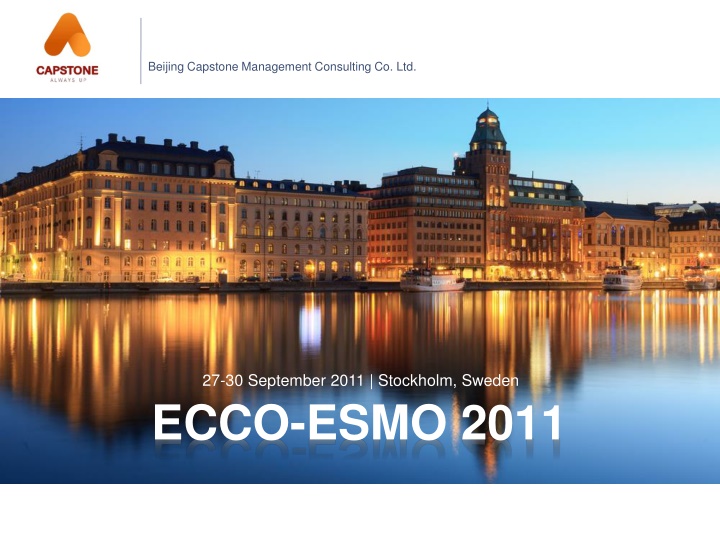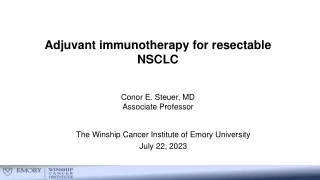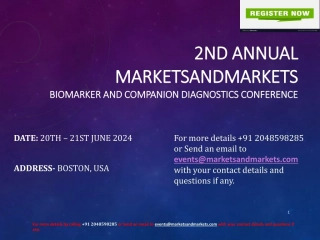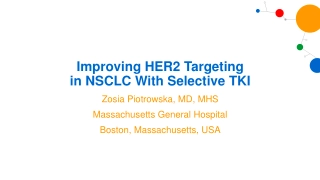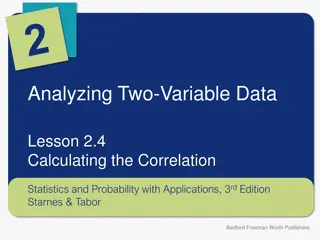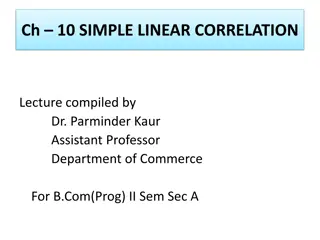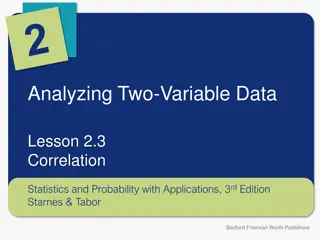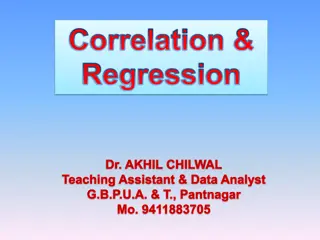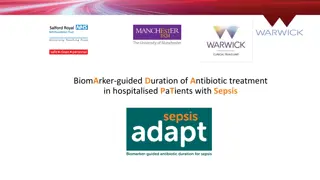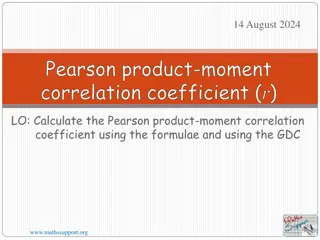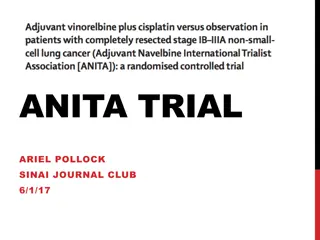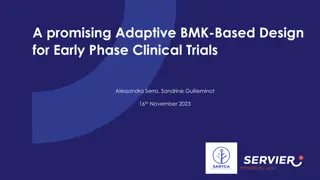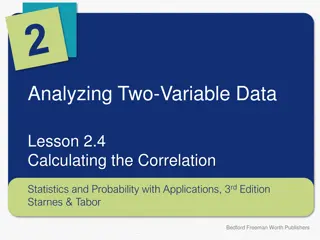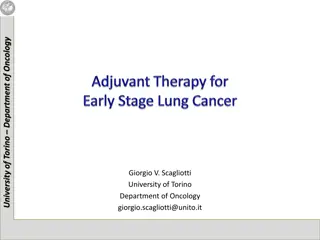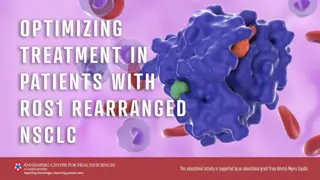Biomarker Correlation in NSCLC Treatment
In this study conducted by Beijing Capstone Management Consulting Co. Ltd., the correlation between biomarkers and treatment response in non-squamous NSCLC patients receiving bevacizumab plus chemotherapy was investigated. The key results indicate that after adjustment for multiple testing, none of the candidate biomarkers showed significant correlation with overall response rate based on baseline plasma levels. The exploratory analysis of progression-free survival (PFS) also did not yield significant associations. This research sheds light on the complexity of biomarker evaluation in cancer treatment.
Download Presentation

Please find below an Image/Link to download the presentation.
The content on the website is provided AS IS for your information and personal use only. It may not be sold, licensed, or shared on other websites without obtaining consent from the author.If you encounter any issues during the download, it is possible that the publisher has removed the file from their server.
You are allowed to download the files provided on this website for personal or commercial use, subject to the condition that they are used lawfully. All files are the property of their respective owners.
The content on the website is provided AS IS for your information and personal use only. It may not be sold, licensed, or shared on other websites without obtaining consent from the author.
E N D
Presentation Transcript
Beijing Capstone Management Consulting Co. Ltd. 27-30 September 2011 | Stockholm, Sweden ECCO-ESMO 2011
Special thanks to the ETOP reviewers Enriqueta Felip, Barcelona, Spain Solange Peters, Lausanne, Switzerland
Table of contents Biomarkers Early-stage/locally-advanced NSCLC Metastatic NSCLC 1st line Maintenance Later lines Elderly Trial design
#9003: Biomarker analysis in BO21015, a Phase II randomized study of first-line bevacizumab combined with carboplatin-gemcitabine or carboplatin-paclitaxel in patients with advanced or recurrent non-squamous NSCLC T Mok Study objective To explore correlation between biomarker candidates and best overall response to bevacizumab (BEV) plus chemotherapy in NSCLC Study type/design ABIGAIL: randomized, multicentre, Phase II trial Up to 6 cycles (q21d) of BEV 7.5 mg/kg or 15 mg/kg combined with carboplatin-gemcitabine (CG) or carboplatin-paclitaxel (CP) Primary endpoint: Correlation of baseline plasma biomarker levels with best overall response to chemotherapy + BEV bFGF; E-selectin; ICAM; PLGF; VEGFA; VEGFR1; VEGFR2 Patients 303 patients with advanced/recurrent non-squamous NSCLC (biomarker evaluable population, n=287) Median age 60 years; 60% male; ~65% ECOG PS 1; 85% white; ~30/~43/~27% never/former/current smokers Mok et al. EJC: 2011; (suppl; abstr 9003)
Key results Primary endpoint: overall response rate relative to baseline candidate biomarker status Low BM level High BM level Logistic regression Responders (%) Responders (%) N N Odds ratio* 95% CI P-value bFGF 142 45 141 43 1.07 0.63 1.80 0.813 E-selectin 142 39 141 48 1.81 1.06 3.08 0.029 ICAM 142 44 141 43 1.09 0.64 1.85 0.748 PLGF 146 44 56 43 1.16 0.58 2.33 0.676 VEGFA 140 44 140 45 1.22 0.72 2.09 0.460 VEGFR1 142 49 141 39 0.77 0.46 1.29 0.319 VEGFR2 143 39 140 49 1.44 0.85 2.45 0.176 After adjustment for multiple testing, none of the candidate biomarkers correlated with overall response rate according to baseline plasma level Definition of candidate biomarker (BM) level: low median; high >median; *Odds ratio: high vs. low BM level BEP population patients pooled; all patients received bevacizumab; covariates: treatment, biomarker level (dichotomized) and baseline prognostic factors; statistically significant if p 0.007 (0.05/7 adjusted for multiple testing) Mok et al. EJC: 2011; (suppl; abstr 9003)
Key results Exploratory analysis of PFS relative to candidate biomarker status Low BM level High BM level Cox regression No. of events, n (%) Median PFS, months No. of events, n (%) Median PFS, months N N HR 95% CI P-value bFGF 142 116 (82) 7.2 141 124 (88) 6.5 1.21 0.92 1.59 0.170 E-selectin 142 119 (84) 6.6 141 121 (86) 6.8 0.94 0.72 1.24 0.684 ICAM 142 118 (83) 7.0 141 122 (87) 6.3 1.18 0.89 1.56 0.250 PLGF 146 122 (84) 6.7 56 51 (91) 6.3 1.20 0.85 1.71 0.308 VEGFA 140 111 (79) 7.4 140 126 (90) 6.1 1.57 1.17 2.09 0.002 VEGFR1 142 119 (84) 7.2 141 121 (86) 6.2 1.14 0.87 1.49 0.351 VEGFR2 143 120 (84) 6.7 140 120 (86) 6.9 0.95 0.72 1.26 0.724 Lower plasma VEGFA at baseline was associated with a longer PFS Biomarker evaluable population patients pooled: all patients received bevacizumab; covariates: treatment, biomarker level (dichotomized) and baseline prognostic factors; statistically significant if p 0.007 (0.05/7 adjusted for multiple testing) N.B. Absence of control arm precludes determination of predictive and/or prognostic value of the tested BM candidate Mok et al. EJC: 2011; (suppl; abstr 9003)
Conclusions None of the biomarkers studied correlated with overall response rate Low baseline VEGFA levels were associated with longer PFS in exploratory analysis (p=0.002) However, predictive and/or prognostic value cannot be determined in this study due to lack of control arm Efficacy and safety profiles were similar to those observed in previous studies of BEV in advanced non-squamous NSCLC Exploratory analyses for further biomarkers are ongoing Mok et al. EJC: 2011; (suppl; abstr 9003)
#26LBA: Results of a pilot external quality assurance scheme for somatic EGFR mutation testing in non-small cell lung cancer managed by EMQN, ESMO, ESP, and ETOP N Normanno Study objective To define the methodology and detect any inherent material problems in assessing EGFR mutation analyses in the Pan-EU EQA Collaboration of experts in pathology (ESP), genetics (EMQN) and lung cancer (ETOP, ESMO, AIOM) Study type/design Pilot phase of the Pan-EU EQA for somatic EGFR mutation analyses (registration of open phase ends 30 September 2011) 25 laboratories across 13 countries: Provided with 10 formalin fixed paraffin embedded samples from NSCLC cell lines with different EGFR mutations Registered with the EMQN Performed DNA extraction and analysis using their usual method Laboratory results were scored for accuracy ESP, European Society of Pathology; EMQN, European Molecular Genetics Quality Network; ETOP, European Thoracic Oncology Platform ESMO, European Society for Medical Oncology; AIMO, Italian Association of Medical Oncology; EQA, External Quality Assessment Normanno et al. EJC: 2011; (suppl; abstr 26LBA)
Key results Methodology used by participating labs Genotyping errors Number of errors 8% 6 Error rate 25 4% 4% 20.821.720.8 20.8 5 42% 20 17.4 Error rate (%) No. of errors 4 34% 15 3 10 4% 4% 2 4.2 4.2 42% 5 DxS / Therascreen kit / ARMS 1 0 Fragment length analysis 0 0 Pyrosequencing / Fragment length analysis / SNaPshot 0 0 34% Sequencing 1 2 3 4 5 6 7 8 9 10 Sequencing / Fragment length analysis / Tagman PCR Sequencing / High Resolution Melt Sample Number Sequencing / Pyrosequencing / High Resolution Melt Normanno et al. EJC: 2011; (suppl; abstr 26LBA)
Conclusions The standard of genotyping in EGFR mutation testing for NSCLC is good, with a low level of true diagnostic errors Incidence of clerical errors was high suggesting that some laboratories had failures in checking processes The standard of reporting is more variable with many laboratories reporting the genotyping result in isolation of any interpretation Robust EQA will harmonize reporting and analytical practices Benefit patients with NSCLC Transferable to future mutational testing EQA, External Quality Assessment Normanno et al. EJC: 2011; (suppl; abstr 26LBA)
#9092: Efficacy of tyrosine kinase inhibitor for non-adenocarcinoma NSCLC patients with EGFR mutation S Cho Study objective To determine the incidence of EGFR mutations and evaluate the efficacy of EGFR TKIs in non-adenocarcinoma NSCLC patients with EGFR mutation Study type/design Assessment of single centre data: assessment of patients with non-adenocarcinoma NSCLC (n=250) Somatic mutation in exons 18 to 21 of EGFR were detected using a polymerase chain reaction (PCR)-based assay Patients Twenty patients had EGFR mutation Twelve of them were treated with EGFR-TKI: seven patients had deletion mutation in exon 19 and one had L858R mutation Cho et al. EJC: 2011; (suppl; abstr 9092)
Key results No complete response in patients treated with TKI (n=12): Partial response in 6 patients (50%), stable disease in 3 patients (25%), disease progression in 3 patients (25%) PFS OS 1.0 1.0 Progression-free survival (%) mPFS = 3.67 mOS = 30.23 0.8 0.8 Overall survival (%) 0.6 0.6 0.4 0.4 0.2 0.2 0.0 0.0 0 5 10 15 0 10 20 30 40 Months Months Patients with deletion exon 19 or L858R mutation (n=8) Partial response in 5 patients (62.5%), stable disease in 2 patients (20%), disease progression,in 1 patient (12.5%) Median PFS = 4.5 months, median OS = 30.2 months Cho et al. EJC: 2011; (suppl; abstr 9092)
Conclusions Disease control rate was significant in non-adenocarcinoma patients treated with EGFR-TKIs, although median PFS was lower than in patients with adenocarcinoma In patients with exon 19 or L858R mutations, there was a more prolonged median PFS, suggesting that these active mutations may support positive treatment outcome in patients with non-adenocarcinoma A further large study is warranted to confirm these findings Cho et al. EJC: 2011; (suppl; abstr 9092)
EARLY-STAGE LOCALLY-ADVANCED NSCLC
1st line METASTATIC NSCLC
#9001: A retrospective subgroup analysis of EGFR immunohistochemistry (IHC) expression by Histo-Score correlated to outcomes from the BMS099 1st line phase III NSCLC trial of cetuximab (Cet) plus carboplatin/taxane T Lynch Study objective To investigate the predictive role of tumour EGFR expression levels in the efficacy of cetuximab plus first-line chemotherapy in advanced NSCLC Study type/design BMS099: Phase III trial Tumour EGFR expression levels measured in tumour tissue specimens using EGFR IHC Histo-Score (H-Score) Subjects were classified into high ( 200) and low (<200) EGFR expression groups Patients 676 patients with advanced NSCLC Tissue specimens were available for 148 of 676 subjects Lynch et al. EJC: 2011; (suppl; abstr 9001)
Key results Secondary endpoint: ORR (by IRC evaluation) EGFR H-Score <200 CT + Cetuximab (n=39) EGFR H-Score 200 CT + Cetuximab (n=35) CT CT (n=36) (n=33) PR or CR, n 8 9 14 6 ORR (%) 95% CI 20.5 9.3 36.5 25.0 40.0 18.2 7.0 35.5 12.1 42.2 23.9 57.9 A higher ORR was observed for the high-EGFR expression group compared with the low group in the cetuximab treated-arm, but not in the chemotherapy alone arm Test for interaction of ORR and biomarker status; p=0.087 Lynch et al. EJC: 2011; (suppl; abstr 9001)
Conclusions Addition of cetuximab to patients with high EGFR H-Score results in greater ORR benefit compared with those with low EGFR H-Score (p=0.087) No significant interaction between ORR and biomarker status was seen for OS or PFS Further work is required to understand the role of EGFR H-Scores in selecting NSCLC patients who will receive increased benefit from cetuximab therapy The small sample size of the BMS099 biomarker data set limits the interpretation of this analysis Lynch et al. EJC: 2011; (suppl; abstr 9001)
#9028: Gemcitabine and cisplatin followed by concurrent gemcitabine and radiotherapy or sequential radiotherapy alone in unresectable stage III NSCLC G Kerner Study objective To evaluate the outcome of concurrent and sequential chemoradiotherapy in unresectable stage III NSCLC Study type/design 2-arm study Arm A: Gemcitabine (G) + cisplatin (C) followed by concurrent G+ radiotherapy Arm B: G + C followed by radiotherapy alone Doses Concurrent: initially G 1125 mg/m2 on days 1/8 and C 80 mg/m2 on day 1 of each 21- day cycle; then weekly G 300 mg/m2 with 5 weeks of radiotherapy (60 Gy) Sequential: 2 4 cycles of chemotherapy then 5 weeks of radiotherapy alone Endpoints: PFS and OS Patients 214 patients received concurrent chemoradiation and 69 received sequential chemoradiation Median age 62-64 years ; 70-74% male; patients on sequential therapy had lower PS at baseline than concurrent therapy group (majority ECOG 1 vs ECOG 0); 2-7/40-41/52-58% never/former/current smokers Kerner et al. EJC: 2011; (suppl; abstr 9028)
Key results: efficacy PFS OS Concurrent chemoradiotherapy Sequential chemoradiotherapy 1.0 1.0 Progression free survival 0.8 0.8 Overall survival 0.6 0.6 0.4 0.4 0.2 0.2 0.0 0.0 0 20 40 Time (months) 60 80 100 120 0 20 40 Time (months) 60 80 100 120 Median PFS is 16 months for concurrent and 14 months for sequential approach OS is 26.1 months for concurrent and 17.8 months for sequential approach Kerner et al. EJC: 2011; (suppl; abstr 9028)
Key results: safety Radiation-related adverse events Concurrent (%) Sequential (%) CTC grade dysphagia 0 1/2/3 69/20/12 93/3/4 CTC grade esophagitis 0 1/2/3/4/5 73/17/9/1/1 93/3/3/1/0 CTC grade radiation pneumonitis 0/1/2/3/4/5 34/46/19/1/0/1 38/48/11/2/0/2 CTC, common toxicity criteria Kerner et al. EJC: 2011; (suppl; abstr 9028)
Conclusions Concurrent chemoradiotherapy with gemcitabine as radiosensitizer gives comparable results as reported for high- dose chemoradiotherapy regimens 24% of patients were not fit enough to be treated with concurrent chemoradiotherapy schedules Concurrent chemoradiotherapy is associated with more (low CTC grade) dysphagia and oesophagitis complaints CTC, common toxicity criteria Kerner et al. EJC: 2011; (suppl; abstr 9028)
Maintenance METASTATIC NSCLC
#34LBA: Final efficacy outcomes for patients with advanced non- squamous non-small cell lung cancer randomized to continuation maintenance with bevacizumab or bev+pemetrexed after first-line bev- cisplatin-pemetrexed treatment F Barlesi Study objective To investigate the use of pemetrexed (Pem) in addition to standard bevacizumab (BEV) continuation maintenance therapy in NSCLC Study type/design AVAPERL study: randomized, open-label Phase III trial 4 cycles (q3w) of BEV 7.5 mg/kg + Pem 500 mg/m2 + cisplatin 75 mg/m2 followed by randomization to maintenance therapy: Arm A: BEV q3w until PD Arm B: BEV + Pem q3w until PD Endpoint: PFS from beginning of induction therapy Patients 125 patients randomized to BEV, 128 patients to Bev+Pem Median age 60 years; ~57% male; 46-55% ECOG PS 1; 86-92% adenocarcinoma; ~26/~50/~24% never/former/current smokers Barseli et al. EJC: 2011; (suppl; abstr 34LBA)
AVAPERL trial designa First-line induction 4 cycles, q3w Continuation maintenance q3w until PD Arm A: bevacizumab CR/PR/SD per RECISTc Previously untreated stage IIIB IV nsNSCLC Bevacizumabb + pemetrexedb + cisplatinb R Arm B: bevacizumab + pemetrexed PD Stratification factors: Gender Smoking status Response at randomization Follow-up nsNSCLC, nonsquamous non small cell lung cancer aRandomized, open-label, phase III study; bDose of bevacizumab = 7.5 mg/kg; dose of pemetrexed = 500 mg/m2; dose of cisplatin = 75 mg/m2. RECIST-related end points measured from the preinduction phase Barseli et al. EJC: 2011; (suppl; abstr 34LBA)
Key results PFS from inductiona PFS subgroup analysis Favours combination Favours BEV Hazard ratio alone BEV+Pem 10.2 months (81 events) BEV 6.6 months (104 events) HR, 0.50 (0.37 0.69); p<0.001 100 ITT population (n=253) 0.54 Progression -free survival (%) Age <65 y (n=176) 0.53 75 0.57 Age 65 y (n=77) ECOG PS 0 (n=118) 0.43 ECOG PS 1 (n=126) 0.60 50 Never smoker (n=64) 0.40 Current/past smoker (n=188) 0.59 25 Adenocarcinoma (n=225) 0.52 SD prior to randomization (n=116) 0.64 CR/PR prior to randomization (n=137) 0 0.46 0 3 6 9 12 15 18 0.0 0.2 0.4 0.6 0.8 1.0 1.2 1.4 1.6 1.8 2.0 Time (months) Patients at risk Hazard Ratio (95%) Cl BEV+Pem BEV 128 125 126 122 103 73 66 38 25 12 4 2 0 0 a Randomized patients, intent-to-treat population Pem + BEV maintenance treatment was associated with a marked increase in PFS over BEV alone Positive effect on PFS was observed in all subgroups studied Barseli et al. EJC: 2011; (suppl; abstr 34LBA)
Conclusions Continuation maintenance with BEV+Pem achieved a PFS benefit of unprecedented magnitude (10.2 months; HR, 0.50; p<0.001) over BEV alone Both regimens were well tolerated but AEs occurred more frequently in the combination treatment group, with some differences due to toxicities commonly attributed to chemotherapy OS data available so far favour BEV+Pem maintenance treatment Overall, the AVAPERL results strongly favour the use of BEV+Pem as continuation maintenance therapy in patients with non-squamous NSCLC Barseli et al. EJC: 2011; (suppl; abstr 34LBA)
#9020: Use of bevacizumab after induction therapy is associated with survival benefit in patients with NSCLC in the ARIES observational cohort study (OCS) MP Kosty Study objective To investigate efficacy of BEV maintenance therapy on OS and PFS after induction with BEV and first-line chemotherapy (CT) in NSCLC Study type/design Observational cohort study in which choice of CT, BEV dose and schedule is based on investigator s decision Analysis between No BEV maintenance population: induction period (IP) defined as 12 18 weeks of CT ( 4 6 cycles) within 18 weeks of initial BEV+CT treatment BEV maintenance population: treated with BEV beyond the IP Key results 1967 BEV-treated patients with advanced NSCLC were enrolled (to Feb 2011) 1213 patients survived progression-free beyond their IP 6 month PFS and 1-year OS were higher in the BEV maintenance population than the group who did not receive BEV beyond the IP (44 vs 33%, p=0.001; 59 vs 47%, p<0.001) Key conclusion In this real-world population, maintenance therapy with BEV beyond induction with first- line CT+BEV improves OS and PFS Kosty et al. EJC: 2011; (suppl; abstr 9020)
Later lines METASTATIC NSCLC
#27LBA: A Phase II study of sorafenib in patients with locally advanced and/or metastatic (stage IIIB or IV) non-small cell lung cancer (NSCLC) with a K-Ras mutation A Dingemans Study objective To investigate the use of sorafenib in NSCLC with K-Ras mutation Study type/design Single arm Phase II study Inclusion criteria: stage IV NSCLC with proven K-Ras mutation; progression after 1 platinum doublet; ECOG 0-2; asymptomatic brain metastasis allowed All patients were treated with sorafenib (400 mg, bid) Primary endpoint: rate of no progression at 6 weeks Secondary endpoint: PFS Patients 57 patients with stage IV NSCLC received at least one dose of sorafenib Mean age 58.5 years; 28% male; 21/77% former/current smokers ECOG PS 0/1/2: 40/53/7% 2nd/3rd/ 4th line of treatment: 54/28/18% 81% adenocarcinoma Median duration of treatment 9 weeks (range 0-61 weeks) Dingemans et al. EJC: 2011; (suppl; abstr 27LBA)
Key Results Secondary efficacy endpoint: PFS Primary endpoint: No progression at 6 weeks 1.0 Median PFS: 2.3 months (95% CI: 1.6-3.0) 0.8 Cumulative survival 0.6 Efficacy Partial response 9 (16%) 0.4 Stable disease 21 (37%) Progressive disease 27 (47%) 0.2 No progression at 6 weeks 53% 0.0 0 5 10 15 PFS (months) Sorafenib treatment was associated with a PFS of 2.3 months Primary endpoint was achieved Dingemans et al. EJC: 2011; (suppl; abstr 27LBA)
Conclusions Sorafenib shows activity in K-Ras mutated NSCLC Primary endpoint was achieved with no progression within 6 weeks observed in 53% of patients Treatment was associated with median PFS of 2.3 months Sorafenib was well tolerated with few cases of grade 3 or more toxicity WHO-PS 2 patients showed rapid deterioration (PFS of 1.2 months) Further work is required to Identify subgroup of patients who will show prolonged benefit to treatment Understand the effect of specific K-Ras mutation Dingemans et al. EJC: 2011; (suppl; abstr 27LBA)
#9012: A Phase Ib study to evaluate the PI3-kinase inhibitor GDC-0941 with paclitaxel (P) and carboplatin (C), with and without bevacizumab (BEV), in patients with advanced non-small cell lung cancer (NSCLC) H. Groen Study objective To establish the safety and tolerability of GDC-0941 with paclitaxel (P) and carboplatin (C), with and without bevacizumab (BEV) Study type/design 2-arm phase Ib study Arm A: GDC-0941 + C + P ineligible for BEV Arm B: GDC-0941 + C + P eligible for BEV Doses: GDC-09411, 60 to 330 mg PO qd days 1-14 of a 21-day cycle; P, 200 mg/m2 for 4-6 cycles; C, AUC 6 mg/mL.min for 4-6 cycles; BEV, 15 mg/kg every 3 weeks Patients 22 first-/second-line patients with advanced NSCLC Median age 60 years; 68% male; 68% ECOG 1; 77% nonsquamous; 73% first line therapy; 5/68/27% never/former/current smoker Groen et al. EJC: 2011; (suppl; abstr 9012)
Key results Tolerability Treatment-related adverse events seen in 20% of patients (n=20, safety cutoff 25 Feb 2011) were alopecia, asthenia, nausea, stomatitis, neutropenia, rash, decreased appetite (anorexia), leukopenia, peripheral neuropathy, paresthesia, epistaxis and arthralgia All were grade 1 or 2 except for neutropenia. Efficacy Partial responses were seen in 4 of 5 squamous patients, including 1 patient with a pathologic complete response Partial responses were seen in 7 of 20 non-squamous patients Groen et al. EJC: 2011; (suppl; abstr 9012)
Conclusions GDC-0941, P and C ( BEV) combination was well tolerated at doses consistent with preclinical activity Evaluation of 330 mg GDC-0941 + C + P BEV is ongoing Randomized studies are planned Groen et al. EJC: 2011; (suppl; abstr 9012)
#9014: Randomized Phase II trial of NGR-hTNF and chemotherapy in chemo-naive patients with non-small cell lung cancer (NSCLC) - preliminary results V. Gregorc Study objective To investigate effect of the vascular targeting agent NGR-hTNF on PFS in NSCLC Study type/design Ongoing recruitment into randomized Phase II trial of chemo-na ve patients with stage IIIb-IV NSCLC (including those with brain metastasis), stratified by histology (nonsquamous vs squamous) and PS (0 vs 1) Arm A: Chemotherapy for up to 6 cycles plus NGR-hTNF 0.8 g/m2 day 1 until progression Arm B: Chemotherapy alone Key results 112 patients enrolled to date and data from 100 (n=50 per group) have been analyzed Tolerability was similar between the groups except for higher incidence of chills (Grade 1) in the combination group No difference was seen in PFS between the two treatment arms: Nonsquamous histology; 6.2/5.4 months in Arms A/B Squamous histology; 4.5/2.7 in Arms A/B Key conclusion NGR-hTNF and chemotherapy can be given together without safety issues Efficacy data are immature but currently do not appear promising Gregorc et al. EJC: 2011; (suppl; abstr 9014) NGR-hTNF=tumour-homing peptide with human tumour necrosis factor
#9017: Initial detection of the double EGFR mutation (L858R or deletion in exon 19 [del 19] plus T790M) in NSCLC patients with brain metastases and the influence of first-line chemotherapy on outcome to erlotinib - C. Rolfo Study objective To investigate PFS achieved with erlotinib treatment in NSCLC harbouring dual activating mutation and T790M and according to site of metastasis Study type/design Assessment of T790M mutations by TaqMan assay Key results 129 patients with advanced NSCLC De novo T790M mutations were identified in 35% (45 of 129) of EGFR-mutant patients before receiving erlotinib PFS was 12 months for patients with T790M mutation and 18 months for those without (p=0.05) Among patients with the T790M mutation, PFS was lower in those with brain metastasis than those without (1 vs 13 months, p=0.002) In patients without the T790M mutation, PFS was not significantly affected by brain metastasis T790M mutation status had no effect on PFS in patients with bone, lung, liver or pleura metastases Key conclusion The T790M mutation in EGFR-TKI na ve patients is a marker for poor prognosis, particularly in patients with brain metastases Initial chemotherapy can play a role in the management of these patients Rolfo et al. EJC: 2011; (suppl; abstr 9017)
#9069: Randomized Phase II study of maintenance enzastaurin following whole brain radiation therapy in the treatment of brain metastases from lung cancer - the MENZA study B. Gr nberg Study objective To determine if maintenance enzastaurin (E) improves outcome of whole brain radiation therapy (WBRT) in lung cancer with brain metastases (BM) Study type/design MENZA trial: randomized, double-blind Phase II study of patients who had received WBRT (20 or 30 Gy) Arm A: E (1125 mg on day 1 followed by 500 mg qd until progression) Arm B: Placebo until progression Primary outcome measure was time to progression (TTP) of BMs Patients 109 patients enrolled at 11 hospitals (Dec 2006 to April 2010) Median age 61-65 years; 60% male; ~70/~30% ECOG 0-1/2 Gr nberg et al. EJC: 2011; (suppl; abstr 9069)
Key results TTP of BMs OS Enzastaurin (n = 55, censored = 35) Placebo (n = 54, censored = 32) Censored observations Enzastaurin (n = 55, censored = 3) Placebo (n = 54, censored = 5) Censored observations 1.0 1.0 0.8 0.8 Survival probability Survival probability HR: 0.93 HR: 1.16 (95% CI: 0.51 1.71; p=0.82) (95% CI: 0.78 1.71; p=0.47) 0.6 0.6 0.4 0.4 0.2 0.2 0.0 0.0 0 3 9 12 15 18 21 24 27 30 Overall survival time (months) 6 0 3 9 12 15 18 21 24 27 30 Overall survival time (months) 6 No. at risk Enzastaurin 55 24 11 Placebo No. at risk Enzastaurin 55 32 18 10 Placebo 54 37 19 11 3 3 1 2 0 2 0 1 0 1 0 0 0 0 0 0 6 5 3 4 1 2 1 1 1 0 1 0 0 0 54 28 8 Median TTP is 6.9 months with enzastaurin and 4.9 months with placebo Median OS is 3.8 months with enzastaurin and 5.1 months with placebo TTP, time to progression; BM, brain metastases Gr nberg et al. EJC: 2011; (suppl; abstr 9069)
Conclusions Efficacy Enzastaurin did not delay disease progression or improve survival of lung cancer patients after WBRT It was not associated with any benefit in quality of life Tolerability Enzastaurin was well tolerated in this population WBRT, whole brain radiation therapy Gr nberg et al. EJC: 2011; (suppl; abstr 9069)
#9011: Survival in patients with non-small cell lung cancer which is clinically acquired resistance to gefitinib natural history since progression H Kim Study objective To investigate factors which affect survival of patients with NSCLC who have clinically-acquired resistance to tyrosine kinase inhibitors (TKIs) Study type/design Retrospective review of 81 advanced NSCLC patients who experienced disease progression following tumour response and durable ( 6 months) disease stabilization from first-line or second-line gefitinib Arm A: Resumed TKIs Arm B: TKIs not resumed Primary outcome measure was post-progression survival (PPS) Patients 16 patients resumed TKIs (gefitinib n=11; erlotinib n=5) and 65 did not Most patients were female never-smokers with adenocarcinoma at stage IV with ECOG PS 0-1 Kim et al. EJC: 2011; (suppl; abstr 9011)
Key results OS since disease progression (PPS) 1.0 1.0 TKI resumed (n = 16) TKI not resumed (n = 65) p=0.004 Pemetrexed used (n = 28) Other regimen used (n = 53) p<0.001 0.8 0.8 Cumulative survival Cumulative survival 0.6 0.6 0.4 0.4 0.2 0.2 0.0 0.0 0 10 20 30 40 50 0 10 20 30 40 50 OS since PD (months) OS since PD (months) Median overall PPS was 10.3 months (95%CI; 7.458 13.142) Resuming TKIs increased PPS in the univariate analysis (shown here) but not the multivariate analysis Age, gender, smoking history, histology, ECOG PS at the start of gefitinib, initial stage and platinum-based chemotherapy after gefitinib were not significant predictors for PPS Using pemetrexed after gefitinib showed significantly longer PPS (18.5 vs 8.6 months, HR=0.45, p=0.008) PPS, post-progression survival Kim et al. EJC: 2011; (suppl; abstr 9011)
Conclusions Resuming treatment with TKIs who are believed to have clinically-acquired resistance can have benefits on survival in some NSCLC patients Pemetrexed may improve outcome in patients with acquired resistance to gefitinib Further work is required to improve our management of this patient group Kim et al. EJC: 2011; (suppl; abstr 9011)
#9018: Prospective assessment of combined pemetrexed and erlotinib or gefitinib therapy after the relapse to erlotinib or gefitinib in patients with advanced non-small cell lung cancer having an active epidermal growth factor receptor mutation K Okishio Study objective To evaluate the efficacy and toxicity of pemetrexed combined with erlotinib or gefitinib after the relapse to erlotinib or gefitinib in patients with advanced NSCLC who have an active EGFR mutation Study type/design Phase II trial Treatment: Pemetrexed (500 mg/m2) was administered on day 1, followed by erlotinib or gefitinib on days 2 16 (cycle repeated every 3 weeks until disease progression) Primary outcome measure was disease control rate (DCR) Patients 27 patients with stage IV NSCLC (population evaluable for toxicity and efficacy, n=22) Median age 67 years; 74% female; 74% ECOG PS 1; 96% adenocarcinoma; median number of prior chemotherapy regimens was 2 Okishio et al. EJC: 2011; (suppl; abstr 9018)
Key results Response N % 1.0 1-year PFS rate = 13.7% 6-month PFS rate = 61.8% Complete response 0 0.8 Partial response 7 Probability 0.6 Stable disease 14 Progressive disease 6 0.4 Total 27 0.2 Response rate 7 25.9 0.0 Disease control rate 21 77.8 0 50 100 150 200 250 300 350 400 450 Time (day) Disease control rate 77.8% Median PFS of 7.1 months Okishio et al. EJC: 2011; (suppl; abstr 9018)
Conclusions Pemetrexed plus erlotinib or gefitinib combination treatment leads to a high DCR in patients with advanced NSCLC who have an active EGFR mutation Combination treatment showed acceptable toxicity, with Grade 3/4 toxicities neutropenia, leucopenia, and anemia occurring in 22, 14 and 7% of patients, respectively A Phase III trial for pemetrexed alone versus pemetrexed plus EGFR-TKI after relapse to EGFR-TKI is warranted DCR, disease control rate Okishio et al. EJC: 2011; (suppl; abstr 9018)
Elderly METASTATIC NSCLC
#9072: Pemetrexed (Pem) maintenance therapy in elderly patients with good performance status (PS) - analysis of PARAMOUNT Phase III study of Pem versus placebo in advanced nonsquamous NSCLC C Gridelli Study objective To further investigate efficacy and safety of Pem maintenance therapy in elderly advanced nonsquamous NSCLC patients with good PS Study type/design PARAMOUNT: A Phase III, randomized, double-blind, placebo-controlled study of Pem maintenance (followingPem induction) therapy Subgroup analysis of patients aged 70 and <70 years Key results Median age 73 years in the older group (n=92) and 60 years in the younger group (n=447) Patient characteristics were comparable except for PS (PS 0/1 in 70: 20%/79%; <70: 34%/66%) and sex (M/F 70: 66%/34%; <70: 56%/44%) For the 70 cohort, Pem reduced the risk of progression by 65% (p=0.00041); median PFS was 6.4 months for Pem and 3.0 months for placebo. For the <70 cohort, Pem reduced the risk of progression by 31%; median PFS was 4.0 months for Pem and 2.8 months for placebo Incidence of grade 3/4 toxicities was higher in the Pem arms than the placebo arms in both age cohorts Patients in the 70 cohort experienced a higher incidence of Grade 3/4 toxicities than those in the <70 cohort Key conclusions Pem maintenance treatment is effective in elderly patients with good PS Grade 3/4 hematologic toxicities were more common in older patients Gridelli et al. EJC: 2011; (suppl; abstr 9072)
